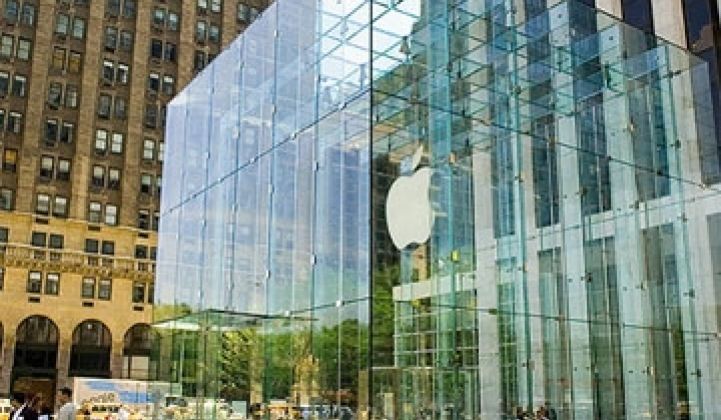Tesla Motors announced Thursday that it had hired George Blankenship, the former architect of Apple's successful retail store rollout, to lead an ambitious retail expansion that targets 50 showrooms over the next few years.
Blankenship, 57 years old and a 20-year GAP veteran, will build out the car maker's global network of stores to coincide with the launch of the Model S sedan in 2012.
The Palo Alto car maker, which last month launched a $211 million IPO, presently has 13 showrooms, with eight located in the United States. Its retail strategy has not yet been widely reported, but this move is an ambitious effort to take control of its own sales and service operations and capture the revenue and customer feedback that traditional auto manufacturers cede to a network of dealers.
Tesla said Blankenship should be a crucial piece of the puzzle. He comes to Tesla from Microsoft, where he went last year to help emulate Apple's retail strategy. His service with Apple began in 2000, where as vice president of real estate, he started to identify and acquire retail locations. A year later, the company opened its first store.
Prior to that, he was responsible for opening more than 250 stores a year for GAP.
At Tesla, Blankenship's first job will be to open stores in Tokyo, Toronto and Washington, D.C. -- and that is just the tip of the iceberg. The company's plan is to have about 20 showrooms in operation by the end of the year and about 50 in place over the next several years. Tesla stores today are in major metropolitan areas, including Los Angeles, New York, London, Chicago, Monaco, Munich and Menlo Park.
The company claims its retail strategy is designed to promote efficiency. "We believe we will...be able to better control costs of inventory, manage warranty service and pricing, maintain and strengthen the Tesla brand, and obtain rapid customer feedback," the company reported in a recent filing with the Securities and Exchange Commission.
"Further, we believe we will avoid the conflict of interest in the traditional dealership structure inherent to most incumbent automobile manufacturers where the sale of warranty parts and repairs by a dealer are a key source of revenue and profit for the dealer but often are an expense for the vehicle manufacturer," the filing continues.
IPO Roadshow
You can watch and listen to CEO, founder, and financial backer Elon Musk hype the firm in this IPO roadshow video. Musk is occasionally coarse and seemingly jittery in the video -- or maybe it's just his trademark charismatic intensity.
Musk makes the following points:
- The Tesla distribution system gives the firm a competitive advantage. In Musk's view, the current automotive distribution system is extremely inefficient -- it puts dealers at odds with the OEMs regarding service and inventory. Instead of having tens of thousands of cars on dealer lots, the Tesla uses a Just-in-Time delivery system with cars essentially being made to order. (Which explains the somewhat deserted feel of the Tesla dealership parking lots.)
- Musk claims that Tesla's "DNA" is closer to an Apple or a Google than to GM or Ford. In his words, "There will not be anyone who brings technology to market faster."
- Musk says that investors and customers such as Daimler and Toyota are "putting their money where their mouth is."
- Musk boasts that the Tesla Roadster Sport can "kick the ass of any Ferrari except the Enzo."
In terms of scaling the company, Tesla's hopes rest with their Sedan, not the Roadster. Musk sees the Sedan as merely "step two" and a stepping stone to Tesla becoming "one of the most important car companies of this century." The Sedan will have pricing and model options that get up to 300 miles per charge and will serve as a platform for eventual SUV, Minivan and Cabriolet models.
Deepak Ahuja, the CFO of Tesla (formerly of Ford), also spoke at the lectern. Here are some of his points:
- Tesla had 514 employees in 2009. (They have more than 600 employees by now, and a spectacular burn rate to accompany that headcount.)
- It cost about $125 million to deliver the roadster. It will cost about $400 million to deliver the Sedan, including the Nummi plant. These numbers are an indication of Tesla's capital efficiency, according to the CFO.
- The base model Sedan is $50,000 after the tax credit but the pricing structure allows for a 30 percent "uplift" in ASP once improved range and other options are factored in.
- Tesla looks to build 20,000 units of the Model S per year.
Tesla has received about 2,200 reservations and deposits for the Model S sedans as of March 31.
Because Tesla does not need to carry a large inventory, the stores don't have to be large or include extensive floor space. That is a major departure from the traditional model. Still, the locations aren't cheap. In 2009, the average cost was $500,000. Costs could rise to between $500,000 and $1 million.
But this should give Blankenship plenty of room to develop and apply a creative approach.
As of the publication of this article, Tesla stock was trading at $17.25, a sliver above the IPO strike price.



